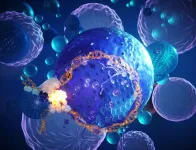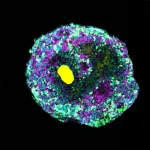(Press-News.org) People with obesity who are long-time exercisers have healthier belly fat tissue and can store fat there more effectively than nonexercisers with obesity, according to a new study from a team of researchers at the University of Michigan.
The research team also grew fat tissue in the lab from cells collected from both exercisers and nonexercisers, and cells from the exercisers developed into a tissue that stored fat more effectively.
"Our findings indicate that in addition to being a means to expend calories, exercising regularly for several months to years seems to modify your fat tissue in ways that allows you to store your body fat more healthfully if or when you do experience some weight gain––as nearly everyone does as we get older," said principal investigator Jeffrey Horowitz, professor of movement science at the U-M School of Kinesiology.
Researchers wanted to see the effects of years of regular exercise on fat tissue, but it's very difficult to design a study to track this long term. Instead, they compared two groups of adults with obesity: 16 people who reported exercising at least four times a week for at least two years—the average was 11 years; and 16 people who'd never exercised regularly but matched in other things like body fat mass, weight and sex. The team took samples of belly fat tissue just under the skin from both groups.
They found that the exercisers had distinct structural and biological characteristics in their fat tissue that increased the capacity to store fat there. The nonexercisers did not have those characteristics. Specifically, the exercisers had more blood vessels, mitochondria and beneficial proteins, and less of a type of collagen that can interfere with metabolism and fewer cells that cause inflammation.
This matters because the healthiest place to store fat is the fat tissue just under the skin where the samples were taken, called subcutaneous adipose tissue. Increasing the capacity to store fat here through exercise reduces the need to store fat in unhealthy places, like in the fat tissue around the organs or in the organs themselves.
"Compared with our previous study in which we examined the effects of three months of training on fat tissue, we generally see these differences are more robust in people who exercise regularly for years versus those who don't exercise," Horowitz said.
It's important to note that increasing the capacity to store fat does not equate to gaining fat, which requires overeating.
"What it means is that if or when people experience weight gain, this excess fat will be stored more 'healthfully' in this area under the skin, rather than in the fat tissue around their organs (visceral fat) or an accumulation of fat in organs themselves, like the liver or heart."
One disease caused by unhealthy fat accumulation that's getting more attention in the U.S. and elsewhere is nonalcoholic fatty liver disease, which occurs most often in people with overweight or obesity. Excess fat builds up in the liver and can cause diseases like cirrhosis (seen most often with alcoholism) or cancer.
Horowitz said it's important to perform long-term studies to track people as they start and maintain an exercise program for several years to see how their fat tissue changes—even if they don't change the amount of fat tissue they have. It's also important to know if there is a type or intensity of exercise that achieves a better response in modifying fat tissue.
In follow-up studies the team will also examine whether the fat tissue grown from exercisers and nonexercisers functions differently, and if there are other health-related differences that may translate to the health of the tissue and the person the cells came from.
The study, "Long-term exercise training has positive effects on adipose tissue in overweight or obesity," appears Sept. 10 in Nature Metabolism. For a copy, contact Laura Bailey, University of Michigan News, 734-647-1848, baileylm@umich.edu.
END
Long-term exercisers have 'healthier' belly fat
2024-09-10
ELSE PRESS RELEASES FROM THIS DATE:
Gene therapy effective in hereditary blindness
2024-09-10
Bothnia dystrophy is a form of hereditary blindness, prevalent in the region Västerbotten in Sweden. A new study at Karolinska Institutet published in Nature Communications shows that gene therapy can improve vision in patients with the disease.
Bothnia dystrophy occurs mainly in the region Västerbotten in Sweden, but the disease has also been identified in other parts of the world. The disease leads to progressive visual impairment due to the destruction of the visual cells in the retina. It is caused by an inherited genetic mutation ...
Report: Conscientiousness, not willpower, is a reliable predictor of success
2024-09-10
CHAMPAIGN, Ill. — According to two psychologists, the field of psychological science has a problem with the concept of self-control. It has named self-control both a “trait” — a key facet of personality involving attributes like conscientiousness, grit and the ability to tolerate delayed gratification — and a “state,” a fleeting condition that can best be described as willpower. These two concepts are at odds with one another and are often confused, the authors report.
“Self-control is a cherished quality. People who have lots of it are celebrated and seen as morally righteous,” wrote University of Toronto psychology professor Michael Inzlicht ...
Advancing prison safety
2024-09-10
The lead article in the current issue of The Criminologist, written by Nancy Rodriguez, University of California Irvine professor of criminology, law and society, shines a light on the lack of prison violence metrics that could help advance safety.
“For the 800,000 persons currently confined and the 200,000 state and federal correctional officers who work within U.S. prisons, the threat of violence is a routine feature of daily life,” she writes. “Accounts from incarcerated persons and staff detail the ever-present threats ...
Towards a better understanding of epigenetics and dynamic gene silencing and reactivation
2024-09-10
Ikoma, Japan – One of the most fascinating discoveries in biology is that cells have mechanisms for dynamically regulating genetic expression. This ability to promote or restrict the transcription of specific genes without altering the DNA sequences themselves is essential to all forms of life, from single-cell organisms to the most complex plants and animal species.
While our understanding of these so-called epigenetic mechanisms is far from complete, remarkable progress has been made in this field with the understanding of the role of the Polycomb Repressive Complex 2 (PRC2). PRC2 is a protein that, in many plants, binds to specific DNA sequences called polycomb ...
Artificial muscles propel a robotic leg to walk and jump
2024-09-09
Inventors and researchers have been developing robots for almost 70 years. To date, all the machines they have built – whether for factories or elsewhere – have had one thing in common: they are powered by motors, a technology that is already 200 years old. Even walking robots feature arms and legs that are powered by motors, not by muscles as in humans and animals. This in part suggests why they lack the mobility and adaptability of living creatures.
A new muscle-powered robotic leg is not only more energy efficient than a conventional one, it can also perform high jumps and fast movements as well as detect and react to obstacles – ...
Researchers develop reaction-induced molybdenum carbides for efficient carbon dioxide conversion
2024-09-09
Molybdenum (Mo) carbides, known for their unique electronic and structural properties, are considered promising alternatives to noble metal catalysts in heterogeneous catalysis. However, traditional methods for preparing Mo carbides suffer from complex processes, stringent synthesis conditions, challenging crystal regulation, and high energy consumption. Additionally, Mo carbides are susceptible to oxidation and deactivation, which poses a significant barrier to their widespread application.
In a study published in Nature Chemistry, a research group led by Prof. SUN Jian from the Dalian Institute ...
Researchers identify factor that drives prostate cancer-causing genes
2024-09-09
For more information, contact:
Nicole Fawcett, nfawcett@umich.edu
EMBARGOED for release at 5 a.m. ET Sept. 9, 2024
Researchers identify factor that drives prostate cancer-causing genes
Factor previously known to play a role in advanced cancer is fundamental in early stages of cancer development
ANN ARBOR, Michigan — Researchers at the University of Michigan Health Rogel Cancer Center have uncovered a key reason why a typically normal protein goes awry and fuels ...
New molecular engineering technique allows for complex organoids
2024-09-09
A new molecular engineering technique can precisely influence the development of organoids. Microbeads made of specifically folded DNA are used to release growth factors or other signal molecules inside the tissue structures. This gives rise to considerably more complex organoids that imitate the respective tissues much better and have a more realistic cell mix than before. An interdisciplinary research team from the Cluster of Excellence “3D Matter Made to Order” with researchers based at the Centre for Organismal Studies and the Center ...
How the brain's inner chamber governs our state of consciousness
2024-09-09
In hospital operating rooms and intensive care units, propofol is a drug of choice, widely used to sedate patients for their comfort or render them fully unconscious for invasive procedures.
Propofol works quickly and is tolerated well by most patients when administered by an anesthesiologist. But what is happening inside the brain when patients are put under and what does this reveal about consciousness itself?
Investigators at U-M who are studying the nature of consciousness have successfully used the drug to identify the intricate brain geometry behind the unconscious state, offering an unprecedented ...
Can coping with a cancer diagnosis contribute to psychological and cardiovascular problems in family members?
2024-09-09
New research suggests that a family member’s cancer diagnosis may increase first-degree relatives’ and spouses’ risks of developing psychological and cardiovascular illnesses. The findings are published by Wiley online in CANCER, a peer-reviewed journal of the American Cancer Society.
Having a family member diagnosed with cancer can be a stressful and traumatic experience for the entire family. Because stress influences not only mental health but also cardiovascular health, investigators explored whether a cancer diagnosis contributes ...







